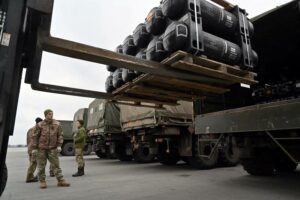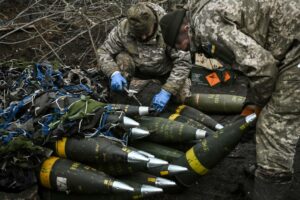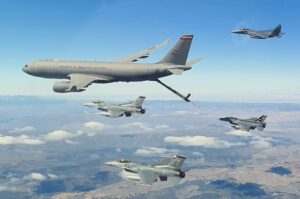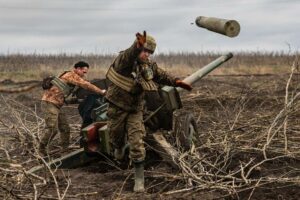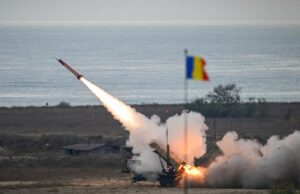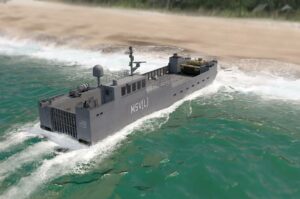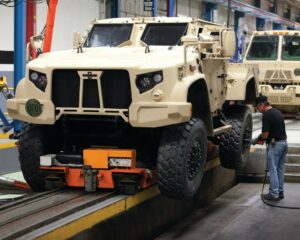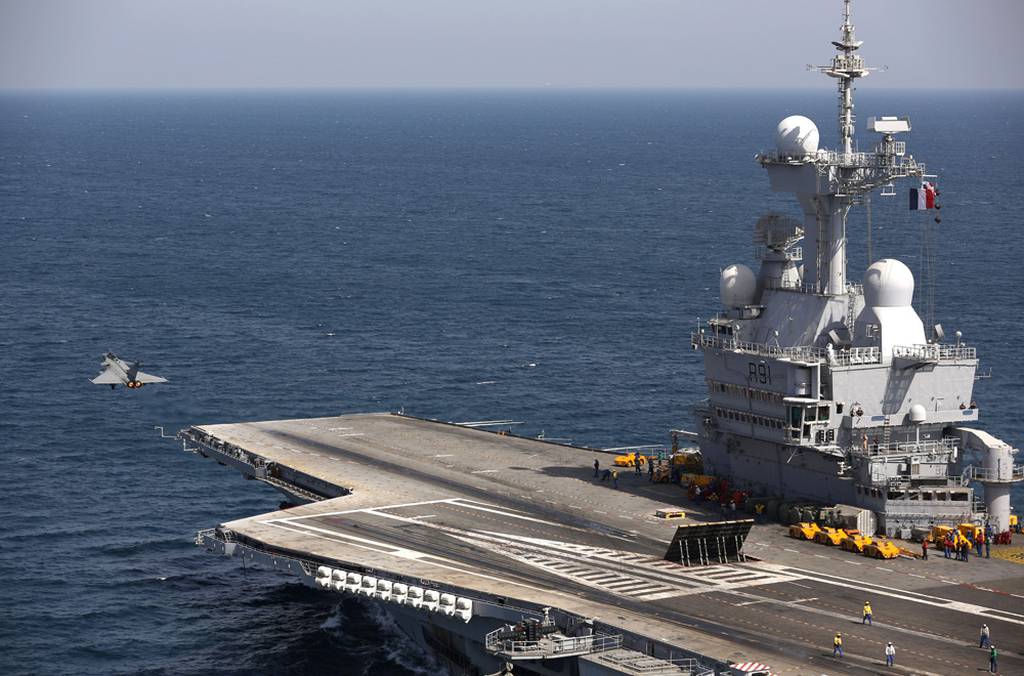
PARIS — Western navies are preparing for wartime scenarios where they may face degraded operational conditions, including a loss of satellite communications, navy commanders from the U.S. and France said at the Paris Naval Conference this week.
The French navy includes two or three days of drills under “back to the ‘80s” conditions whenever it deploys its carrier strike group, which means operating without satellite communications, Navy Chief of Staff Adm. Nicolas Vaujour said at the conference.
“Training like this is quite challenging, and year after year it is more challenging, but it is really interesting to see we are still able to operate,’’ Vaujour said. He joked that the loss of satellite communication means “less PowerPoint sharing between ships” and instead relying on keywords for operations.
Countries including China and Russia have developed weapons to deny the U.S. and others access to space capabilities, according to aerospace analysts. Navies need to make their systems more resilient to attacks, particularly communications, according to Vice Adm. Rajesh Pendharkar, Eastern Naval Commander for the Indian navy.
The U.S. Navy has similar training as France to prepare for a degraded operational environment, such as a day of operating without GPS, U.S. Chief of Naval Operations Adm. Lisa Franchetti said at the conference.
“The harder we are on ourselves, that will make us that much more resilient and successful if we ever have to go to war,” Franchetti said.
She said the Navy needs a renewed emphasis on deception and emissions control, or EmCon, as well as operational security, at a time when “everyone’s on social media” and sharing the location of where they’re going. “We used to be really good at creating confusion in the eyes of adversaries, and that is a skill we need to go back to and make sure that we’re thinking about that all the time,” Franchetti said. “We got a little bit lazy sometimes, in EmCon, we definitely got lazy in operational security.”
Navies and their carrier strike groups are facing new or evolving threats in the face of hypersonic missiles, anti-ship ballistic missiles, drones and cyber warfare, the admirals at the conference said. The battlefield is increasingly transparent, and commanders should assume capabilities will be attacked and degraded during operations, Pendharkar said.
Sea has become a more contested environment, and navies need to think about naval combat “from seabed to space,” according to Vaujour. Maritime airspace is now contested, as shown in the Red Sea and the Black Sea, and that will probably be the case for every future crisis, he said.
The ability of carriers to function as intelligence nodes and using artificial intelligence to integrate battlefield sensor data from their entire strike group will be key to fending off new threats, the French admiral said.
“We must understand what’s going on before the enemy,” Vaujour said. “New technology will give us the opportunity to do that.”
While aircraft carriers face challenges, there’s still no better better way to deliver mobile expeditionary strike, force projection and force protection from the sea, said Adm. Sir Ben Key, First Sea Lord and Chief of Naval Staff of the Royal Navy. He pointed to China building carriers, despite having developed apparent carrier killer capability.
The contemporary battlespace has become more contested for everyone, and the challenge for carrier strike groups is to integrate all available data to create a “superiority bubble” around the carrier, according to Key.
“For years, we have assumed sea control, and so we could invest everything pretty much in local superiority and strike as the principal aim,” Key said. “Now what we’ve got to get back into is thinking more deeply on how we do sea control.”
Rudy Ruitenberg is a Europe correspondent for Defense News. He started his career at Bloomberg News and has experience reporting on technology, commodity markets and politics.
- SEO Powered Content & PR Distribution. Get Amplified Today.
- PlatoData.Network Vertical Generative Ai. Empower Yourself. Access Here.
- PlatoAiStream. Web3 Intelligence. Knowledge Amplified. Access Here.
- PlatoESG. Carbon, CleanTech, Energy, Environment, Solar, Waste Management. Access Here.
- PlatoHealth. Biotech and Clinical Trials Intelligence. Access Here.
- Source: https://www.defensenews.com/naval/2024/01/26/back-to-the-80s-as-french-navy-prepares-for-new-threats/
- :has
- :is
- :where
- 70
- 8
- a
- ability
- Able
- About
- access
- According
- Aerospace
- After
- aim
- aircraft
- airspace
- All
- and
- apparent
- ARE
- around
- artificial
- artificial intelligence
- AS
- assume
- assumed
- At
- Attacks
- available
- back
- Battlefield
- BE
- become
- before
- ben
- Better
- between
- Bit
- Black
- Bloomberg
- Building
- but
- capabilities
- capability
- Career
- carriers
- case
- challenge
- challenges
- challenging
- chief
- China
- combat
- commodity
- Communication
- Communications
- conditions
- Conference
- confusion
- contemporary
- control
- could
- create
- Creating
- crisis
- cyber
- data
- day
- Days
- deception
- deeply
- Defense
- definitely
- deliver
- deploys
- Despite
- developed
- do
- Drones
- during
- eastern
- Emissions
- emphasis
- Entire
- Environment
- Europe
- EVER
- Every
- everyone
- everything
- evolving
- experience
- Eyes
- Face
- facing
- First
- For
- Force
- France
- French
- from
- function
- future
- get
- Give
- Go
- going
- good
- got
- gps
- Group
- Group’s
- harder
- Have
- having
- he
- his
- How
- HTTPS
- if
- images
- in
- includes
- Including
- increasingly
- Indian
- instead
- integrate
- Intelligence
- interesting
- into
- Invest
- IT
- ITS
- jpg
- Key
- keywords
- killer
- like
- little
- local
- location
- loss
- make
- Maritime
- Markets
- May..
- means
- missiles
- Mobile
- more
- much
- must
- Need
- needs
- New
- news
- Nicolas
- no
- nodes
- now
- of
- off
- on
- operate
- operating
- operational
- Operations
- Opportunity
- or
- Others
- ourselves
- paris
- particularly
- plato
- Plato Data Intelligence
- PlatoData
- politics
- Prepare
- Prepares
- preparing
- pretty
- Principal
- probably
- Projection
- protection
- quite
- really
- Red
- relying
- renewed
- Reporting
- resilient
- royal
- Russia
- s
- Said
- satellite
- scenarios
- SEA
- security
- see
- sensor
- sharing
- should
- shown
- similar
- Sir
- skill
- So
- Social
- sometimes
- Space
- Staff
- started
- Still
- strike
- successful
- such
- sure
- Systems
- Technology
- that
- The
- their
- they
- think
- Thinking
- this
- this week
- threats
- three
- time
- to
- Training
- transparent
- two
- u.s.
- U.S. Navy
- under
- understand
- us
- used
- using
- vice
- war
- Way..
- we
- Weapons
- week
- WELL
- Western
- What
- when
- whenever
- which
- will
- without
- year
- years
- zephyrnet

